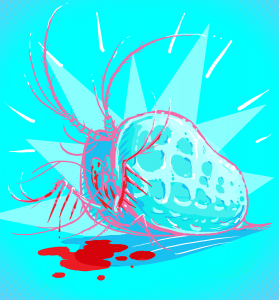A letter to the editor by Professor Tiberius Earwig Ph.D., FGS, as provided by Dr Rebecca Siân Pyne
Art by Leigh Legler
Dear Sir/Madam,
I admit that when I heard my research assistant screaming in mortal agony that overcast Tuesday morning in June, I naturally just assumed that he had been his usual careless self. For some reason, I cannot seem to attract the same caliber of minions that I did even a decade ago, but James was the most incompetent of them all. On reflection, he should have been vaporized with extreme prejudice after burning down my laboratory for the second time in as many months and blaming it on Igor.
Igor just happened to be on a two-week walking tour of Transylvanian graveyards and other sites of interest, but the idiot boy tried to pin it on him anyway.
You just can’t get the staff these days.
When I opened the door into the aquarium room, the screaming had mercifully stopped. It was probably just as well I spent all that money on adequate sound proofing, or the neighbors would have complained. Splashes of fresh blood alerted me to the fact that a different and more terminal calamity had befallen my unlucky subordinate. My new specimen was out of her tank and gorging on his flesh. Gore turned the elegantly ornamented carapace crimson as razor sharp claws gouged it to bite sized pieces. Once I ascertained that his dying struggles had not damaged the subject, I was able to appreciate perfection and study the feeding behavior.
Never waste a scientific opportunity, as my mentor Dr. Frankenstein III always used to say before his unfortunate accident (if you can call a dozen angry villagers with pitchforks and flaming torches an accident).
She proved to be a highly adaptable predator, able to hunt on land as well as in the water, beautiful in its design. Based on my experience with related genera, I was able to identify her as female based on the inflated shape of the carapace, males usually being more elongated. Specimen 16-001-TEC/3 (Miranda as I call her in more intimate moments) came from the deepest part of the Irish Sea, a lucky find when I descended into the depths in a submersible rover craft and found a thriving colony.
Igor never said that he was claustrophobic and waited until we reached the bottom to tell me. If the submarine ejector seat I had been working on for years had actually worked, he would have been out of the hatch in an instant and left to swim home. As it was, there was a small fire and black smoke that hung around with nowhere to go until he fetched the extinguisher.
The look on his lop-sided face, the kind of face that not even a mother can love, was one of utter disdain–but it might just have been trapped wind. When someone looks like he does, it is difficult to be certain.

Splashes of fresh blood alerted me to the fact that a different and more terminal calamity had befallen my unlucky subordinate. My new specimen was out of her tank and gorging on his flesh.
To read the rest of this story, check out the Mad Scientist Journal: Spring 2017 collection.
Professor Tiberius Earwig, BSc (Bristol), MSc (Aberystwyth), PhD (Cambridge), is an internationally recognized authority on fossil and recent Ostracoda, with two hundred papers in The Journal of Micropalaeontology, Revista Española de Micropaleontología, Proceedings of the Ussher Society, Deep Sea Biology, Applied Biology and Musicology, and others. After a brief sabbatical at Her Majesty’s Asylum for Criminally Insane Academics, he retired to Whitby, but continues research. Professor Earwig is a member of Anti-Cites, an exclusive dining club which puts the world’s rarest species on the menu. Other interests include Elizabethan Madrigal singing. He writes Shakespearean sonnets and evil haiku.
Dr Rebecca Siân Pyne is a writer, researcher (and mental health first-aider), now based in West Wales, via Cardiff University and the Swiss Federal Institute of Technology, Zurich. She has a PhD in Micropalaeontology, specializing in British Upper Cretaceous ostracods, with published research in Revista Española de Micropaleontología and Palaeogeography, Palaeoclimatology, Palaeoecology. Short stories have appeared in Bête Noire, Macabre Cadaver, Bards and Sages Quarterly, Albedo One, Aurora Wolf, Eschatology, Neo-Opsis, and others. Research assistants include a mad sprollie (springer spaniel x collie) who ensures there is no time for writer’s block.
Leigh’s professional title is “illustrator,” but that’s just a nice word for “monster-maker,” in this case. More information about them can be found at http://leighlegler.carbonmade.com/.
“Further Investigations on a New Species of Giant Carnivorous Ostracod” is © 2017 Dr Rebecca Siân Pyne
Art accompanying story is © 2017 Leigh Legler
